An Interview with Global Heritage Fund’s Santiago Giraldo and Nada Hosking
Deep in the thick jungle brush of northern Colombia’s Sierra Nevada Mountains lay the ruins of Ciudad Perdida, the “Lost City” of the Tayrona people. Built from rammed earth and intricately cut masonry, the buildings of Ciudad Perdida formed the political, economic, and social center of the Tayrona society before mysteriously disappearing in the sixteenth century. Hidden for over four hundred years, this stunning archaeological site has recently begun to reveal its secrets.
Since 2009, Global Heritage Fund has worked at Ciudad Perdida to protect the archaeological ruins, improve visitor management, and empower the local community through development projects. We recently caught up with Santiago Giraldo, our Director of Latin America, and Nada Hosking, our Director of Programs and Partnerships, to discuss the challenges and successes of working at Ciudad Perdida.
…
What is the history of Ciudad Perdida?
Santiago: Ciudad Perdida is one of the most impressive towns built by the Tayrona. Around the beginning of the 16th century, the Tayrona society was comprised of multiple political entities spread out over around 5,000 square kilometers, around 2,000 square miles, on the northern part of the Sierra Nevada de Santa Marta on the Caribbean coast of Colombia.
The city was first built in the middle of the 6th century or 7th centuries CE. It began as a relatively small village, probably set up by agricultural colonists or pioneers moving up the mountain from the coast. Around 1100 to 1200 CE, it had a construction boom and acquired the shape and form that we see now. The city slowly grew up to the size of about 33 to 35 hectares, about 80 acres.

Ciudad Perdida was hidden for over 400 years by the thick jungle brush of northern Colombia’s Sierra Nevada Mountains.
Why is it called the “Lost City?”
Santiago: The site used to be called “B200” because it was the 200th site found on the Buritaca River Basin. But one of the people in the initial archaeology team said, “It looks like a lost city!” Of course, the name stuck because it’s way sexier than B200.
The official name now is Teyuna-Ciudad Perdida Archaeological Park. Teyuna is a mythical hero of the Kogi people, so it adds a bit of Indigenous nomenclature.
Ciudad Perdida was “lost” because it was covered in forest for four hundred years. It was found in the early 1970s by a father and son team of looters who were hunting in the basin. When they shot a wild turkey, it landed on top of an exposed staircase. That’s how they found the access point towards the city.
Other looters got wind of the find, and they ended up fighting. The patron of the looters called the Gold Museum in Bogotá to say, “We found this spectacular site up in the mountains. Would you like to loot it with us?” The director of the museum was not enthusiastic about the looting part, so she called the Colombian Institute of Anthropology and History (ICANH). They sent a team with two of the looters to locate the site, and then they brought in the research team around 1976.
And it was all thanks to a turkey hunting expedition.
Santiago: Yes, serendipity! It’s actually a pretty big component of archaeological discovery. There are people that have it and people that don’t.
What happened after that 1970s discovery? Was the site open to the public right away?
Santiago: There are a number of excavations from 1976 to 1981, with conservation and restoration work. There was a slump and then more work until 1986.
Initially it was thought that the best thing would be to keep the site closed to the public. But in 1981, the archaeologists were working there and suddenly a French dude appeared, all bedraggled and covered with scars from falling. He said, “Is this Ciudad Perdida?” That’s when they realized that it was impossible to keep the site closed to the public. They opened the site to the public in 1981, and it’s been open since then.
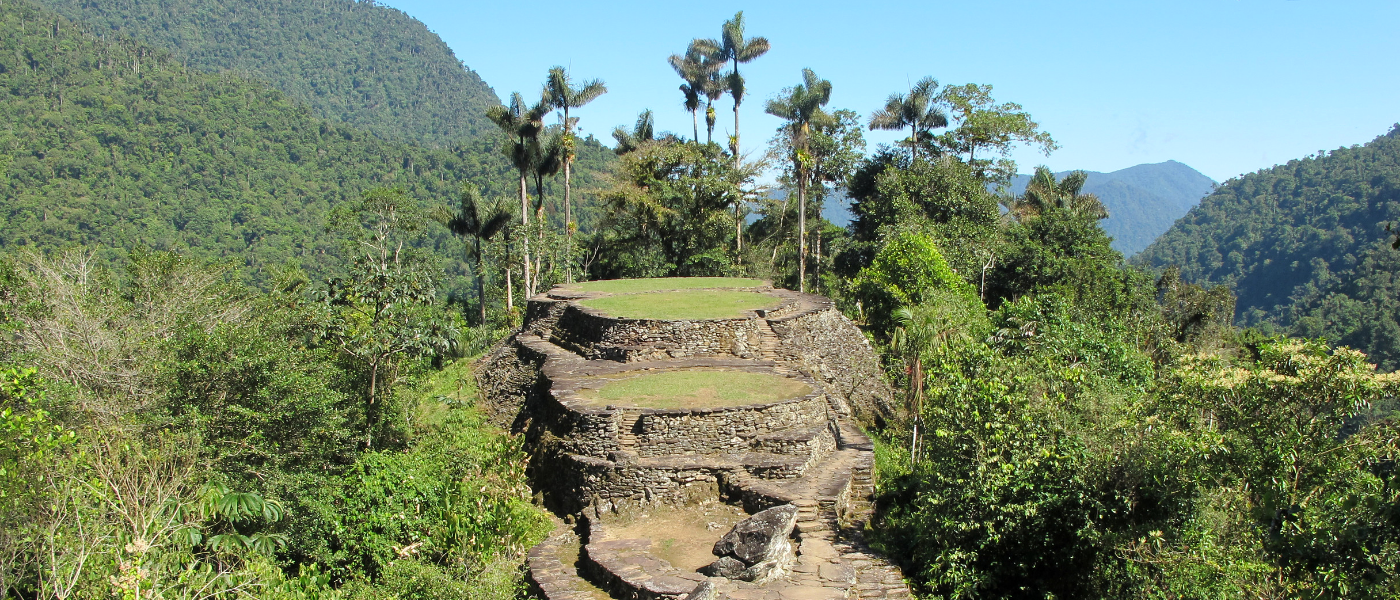
Considered an anti-Machu Picchu, Ciudad Perdida requires a challenging, 17-mile trek.
Many people consider Ciudad Perdida the forefront of adventure travel.
Santiago: Yes, it was conceived of as an anti-Machu Picchu.
Nada: And it still is to this day.
Santiago: The Colombian Institute of Anthropology realized that one of the first lines of conservation defense was to keep access difficult. One of the things we have learned at GHF is that a main problem at many sites is an excess of people. There are just way too many people for sites’ own good. That is what is happening at Angkor, Petra, and Machu Picchu. So ICANH decided many years ago to keep the numbers low at Ciudad Perdida
Why are the numbers at Ciudad Perdida so low?
Santiago: It’s a seventeen-mile hike. We initially had a tourist boom between 1985 and 2000. Then violence got bad with the internal conflict in Colombia, and visitor numbers fell. Around 2001 to 2002, the site was getting about four hundred people per year at the most.
In 2007 there was a demobilization agreement with the paramilitary groups that used to operate in the area. Tourist numbers began picking up, and that was the window of opportunity when GHF came in to be able to fix things and help ICANH control numbers.
What were the first projects GHF undertook at Ciudad Perdida?
Santiago: Initially we had a pilot project. Jeff Morgan, the founder of GHF and the director then, and Stefaan Poortman, the current CEO, called me. At that time, I was the Head of Archaeology at the Colombian Institute of Anthropology and History, and also head of the park at Ciudad Perdida. They called me up and said, “We want to work in Colombia.” I told him we have three archaeological parks, and Jeff asked, “Which one is the coolest?” I said, “Ciudad Perdida, of course!”
Jeff, Stefaan and I flew to Ciudad Perdida and began a pilot project focused on improving facilities. We’d had three to four years of quasi abandonment at the park, so the facilities were very run down. We setup a new kitchen and generator and hired new park rangers.
Later in 2009, while I was finishing my dissertation, I drafted a new comprehensive five to seven year project. We began that project in earnest in January 2010.
Nada: Santiago is the expert when it comes to Ciudad Perdida. I remember when I started at GHF back in 2014, and I saw his name. I was a little starstruck! I haven’t told you this Santiago, have I?
Santiago: You have not!
Nada: I thought, “Wow. He is the archaeologist who knows the most about the site and has done a dissertation about the culture!”
Santiago: We’ve done quite a bit, and conservation work has been excellent. From 2010 until 2017, we had conservation going on every single year. We also had quite a bit of community development. It’s been a very comprehensive, wide-ranging, and multi-year project that went very deep towards solving some of the main issues at Ciudad Perdida.
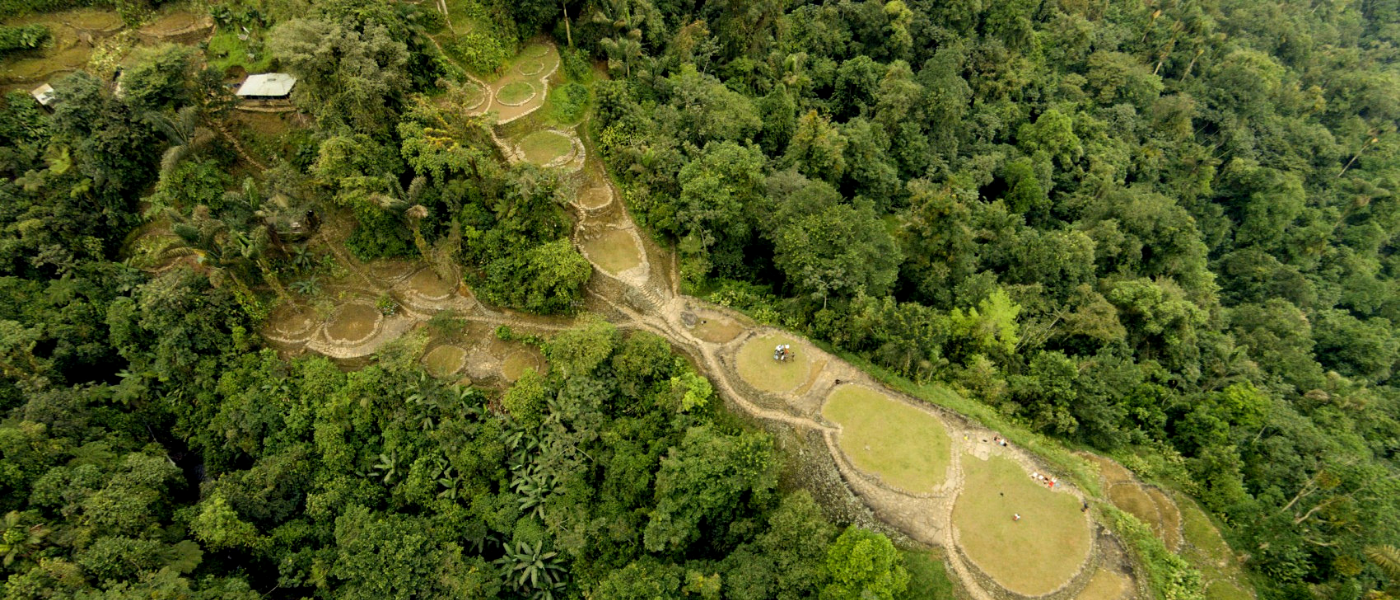
Aerial view of Ciudad Perdida.
How have the numbers at Ciudad Perdida grown from four hundred visitors per year?
Santiago: We now have about 25,000 people per year, so about sixty people per day on average, and the trip cost is relatively high. Up to last year, it was about $300, and this year it will be about $400. Each visit has a high degree of impact on community revenue, even if those are relatively small numbers when comparing Ciudad Perdida to sites such as Angkor, Petra, or Machu Picchu.
The visitor money goes back into the community. All of the guides either local guides or based out of Santa Marta. All the companies and owners of the lodges are local. They are either campesinos, mestizo peasants who live in the area, or part of the Indigenous Kogi or Wiwa folk that live in the area. Everything really is going into the community—all of the cooks, porters, mule drivers, and four-by-four drivers are local. Everybody gets a tiny slice of the pie.
What is your process for involving the local communities?
Santiago: The community was involved from the get-go. Even when the area was closed between 2002 and 2003 because of violence, the local guides kept Ciudad Perdida open. The community has always been involved, and it’s basically impossible to do anything without them. The community philosophy is that the site provides them with their livelihood, be it well or poorly managed by the state. Come what may, they are involved in the process. Because they live in the area as well, it was in their interest to do trail management or to fix up the bridge that we set up.
We came in to make good on a number of conversations we’d already had with the community regarding improvements to the facilities, waster water management, and security. All these were things that we had been discussing with the community for awhile but had been previously impossible to complete.
Nada: Yes, Ciudad Perdida has been one of GHF’s most successful projects. We have learned from Ciudad Perdida that communities must be at the center of our work. Our programs are not just about the heritage sites; if the community is not engaged or does not feel ownership, a project is not going to be successful. We’ve had issues with other projects in the past where we didn’t get enough traction and we had to pull out.
Santiago: That’s an extremely important lesson. No matter what happens, if a site is loved and the community is invested in its care, the community will do everything in its power [to protect it], regardless of whether there is a state or private company interested, or whether there is an NGO interested in preserving it. The community was already invested in Ciudad Perdida’s protection, and we were able to help the government agency that was also invested in its protection. We made good on the fact that there was both institution and community buy-in from the beginning.
Nada: For the project we started in 2018 in Morocco, we are following in Santiago’s footsteps. We are engaging, supporting, and training the communities. We are only going to be there for a certain amount of time, but they will be there for a very long time. By providing the communities with the tools and training they need, they can continue to protect these heritage sites on their own.
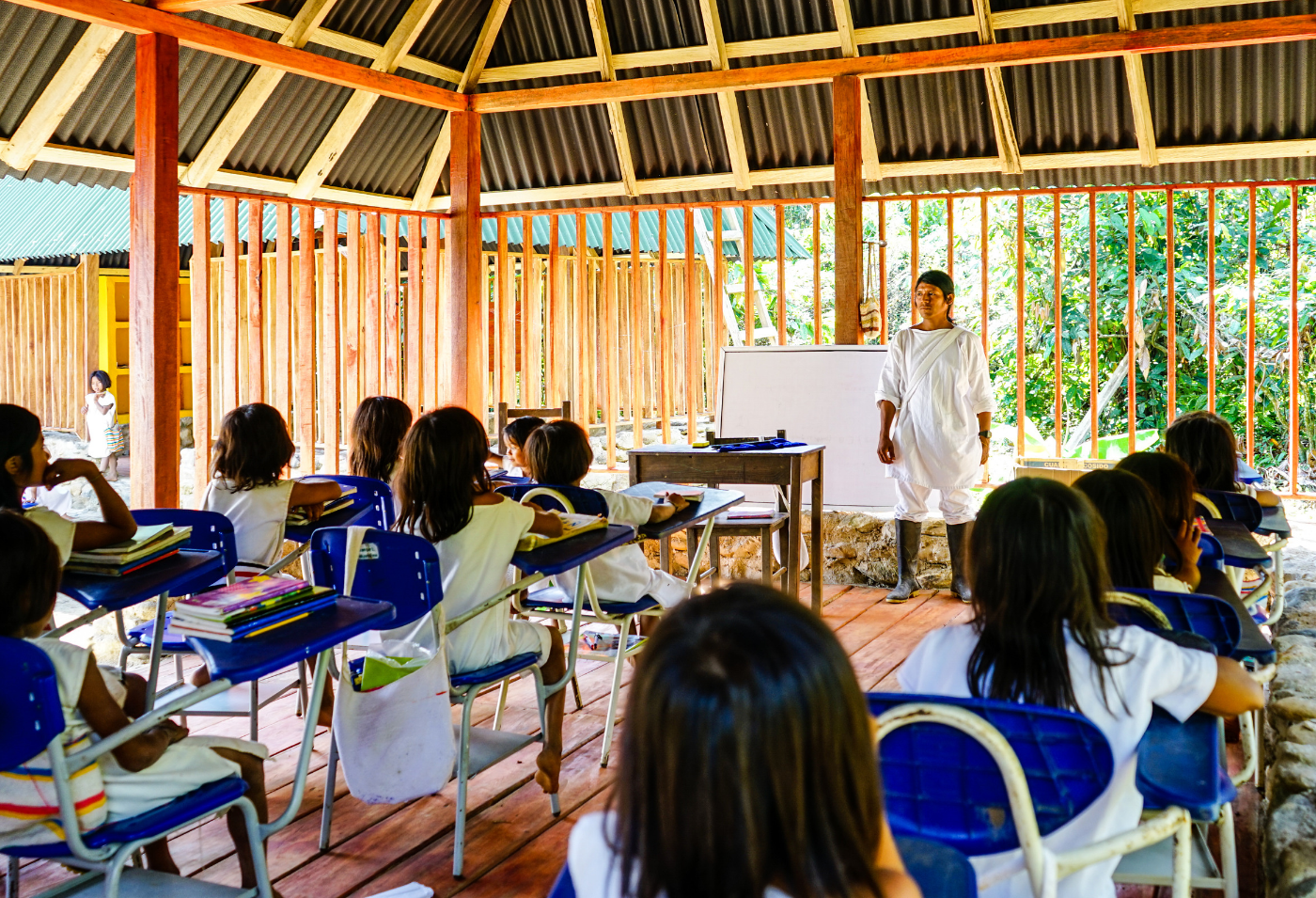
Students attend class at the Ableizhi School near Ciudad Perdida.
Is the school at Ciudad Perdida one such community project that gained a lot of traction?
Santiago: It’s interesting because the school ended up being built the next basin over. We initially pitched the idea to the community that lives right by the trail going up to Ciudad Perdida. There was a lot of back-and-forth and divided opinions about whether they wanted the school. There is a school at the trailhead that we also supported, where we setup curricular materials providing the school kids—whether they were mestizo, campesino, or Indigenous—with the training to be guides.
The community decided that they didn’t want the school right there next to the trail, but the community the next basin over asked for a school. We built the school there, and it has had a lot of traction and been very successful.
Sometimes we will have certain aspects of the projects gain traction in the local communities, or have other aspects that don’t gain much traction in our direct areas of influence—though they may gain traction in our indirect areas of influence. It’s a question of more education, better education, and better educational facilities. These aspects will always be good for communities because they spread the word that these sites are there for the benefit of the local communities.
Nada: You also teach children to be proud of that site and to continue the preservation of the site when they get older, if they choose to.
Santiago: We have a number of young men and women who were eight or ten years old when we began the Ciudad Perdida program. Now, they are working as guides or in some way related to the tourist business at the site.
Another lesson learned is that these sorts of projects take time to be successful. We can’t fix all these issues in a very short period of time. It takes awhile to see improvement.
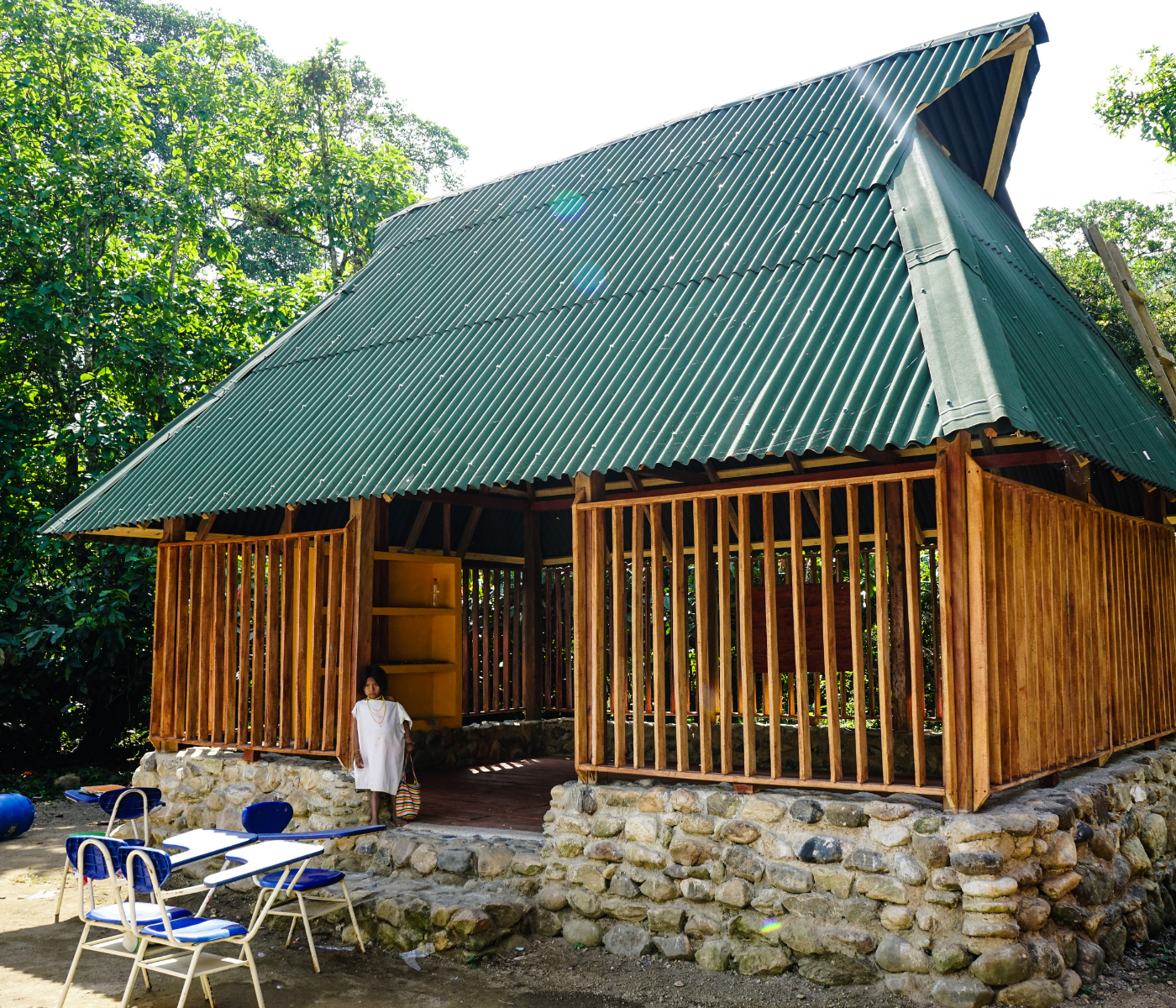
The Ableizhi School at Ciudad Perdida.
Nada: When we set off to invest in building a school for kids, it wasn’t a decision made by GHF, ICANH, or the top leadership of the project. It was a decision made by the community. They had a debate about it, and that’s how it should be for all projects.
In a lot of instances, you see big foundations or governments decide that certain things need to happen and they’re going to make them happen. The community is not invested, so those projects do not succeed. Once you involve the community in the process of building something, it makes that project a lot more successful in the long run.
Santiago: Sure. And it doesn’t mean that the community has to be involved in every single aspect of managing the site. What’s important is that there is buy-in from the community regarding the endgame for the site. If the community is not invested in protecting the site, nobody will be able to do anything. That’s one of the huge differences that we saw at Ciudad Perdida—everybody was really invested in protecting the site.
Everyone has a job to do. In the case of the tour operators and outfitters, they need to provide a really good service with a manageable level of risk. We trained them in wilderness first aid and gave them updates on research so the guides would have the best possible information. We also provided them with a guidebook that is available to the public. That doesn’t mean that they have to be part of the day-to-day management of the site.
As an example, in 2016 we had Hurricane Matthew tear down five hundred trees and litter them all over the park. The community and the guides helped the park rangers clear out the site, showing that they were invested in the site and in their business.
It sounds like you’re saying that sometimes heritage sites may have unconventional needs, like training in wilderness first responses or land management.
Santiago: Absolutely. Sites must be treated on a case-by-case basis. That’s why with GHF we provide a tailor-made approach to each site. There are continuities from project to project, but each site has its own particularities, needs, and challenges.
Nada: And some sites may be under the jurisdiction of the government, while others are under the jurisdiction of the community itself.
Santiago: Generally, there are a number of things you can apply in terms of management philosophy. For example, excess numbers and too much visitation are not good things.
Nada: No, they’re not good for the site, and they’re not good for the visitor experience.
Santiago: We’re seeing backlash in places such as Venice and Paris, where there is such a high influx of people that everyone is completely fed up. Even the governments there can’t keep up with facilities. Paris is receiving about 40 million people per year! It’s just not a good experience.
Nada: Tourism is an economic driver. It pushes governments and the private sector to try and leverage the movement and mobility of people to create jobs and make money. But they don’t think about sustainability from the beginning. They think about sustainability once they’ve made their billions. If you start thinking about sustainability ten years down the road, when you’ve created a monster, it’s too late most of the time.
Santiago: That’s one of the things that has been really important at Ciudad Perdida. Neither the communities nor ICANH wants too much tourism because it becomes completely unmanageable.
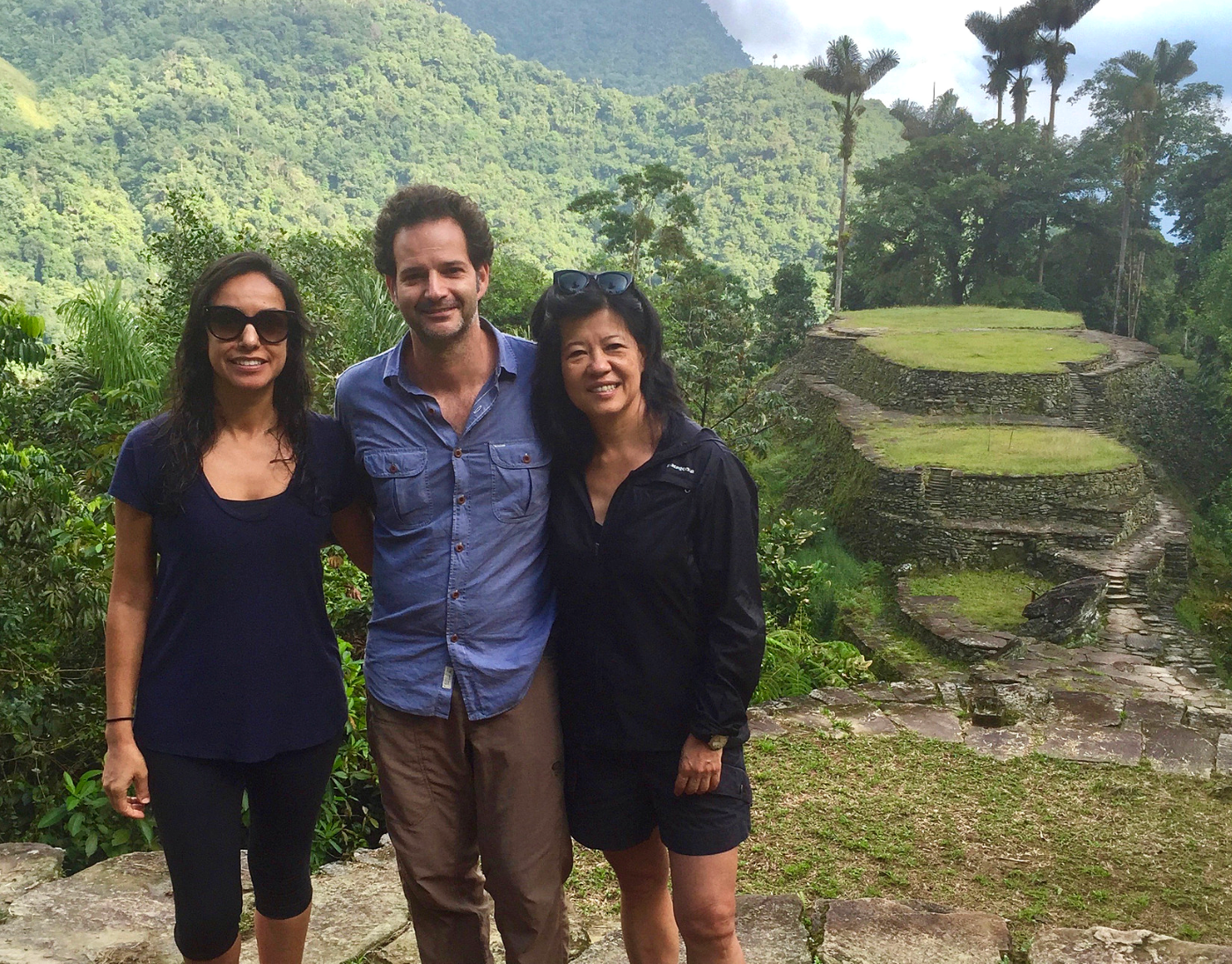
Nada Hosking, Santiago Giraldo, and Joy Ou complete the hike to Ciudad Perdida.
What is it like to visit Ciudad Perdida?
Nada: I am lucky to have seen Ciudad Perdida with Santiago. We went with one of our board members, Joy Ou. She was very brave! Most of the time, people from the United States just want to see the terraces. They want to come in and leave in a helicopter—except for one more brave board member.
Santiago: Yes, Patrick [Franco] walked up and down with me.
Nada: Of course, Santiago can run it. You start in the beginning and run all he way to the park in how many hours?
Santiago: Six hours.
Nada: Basically it’s a marathon! It’s challenging, very hot and humid. It rains, there are rivers to cross, and it’s not an easy trail. We started at 4pm and hiked in the dark. We slept on hammocks, which was a first for me. It was a very comfortable hammock in an open space, not indoors or anything—you’re in the middle of the jungle, swinging from a hammock all night.
We hiked all the next day. At the end, Santiago said we needed to rush before the Buritaca River filled up. Every day it starts raining and the Buritaca River fills, so you can’t cross it. We managed to just make it.
Santiago: Yes, we made it just in time.
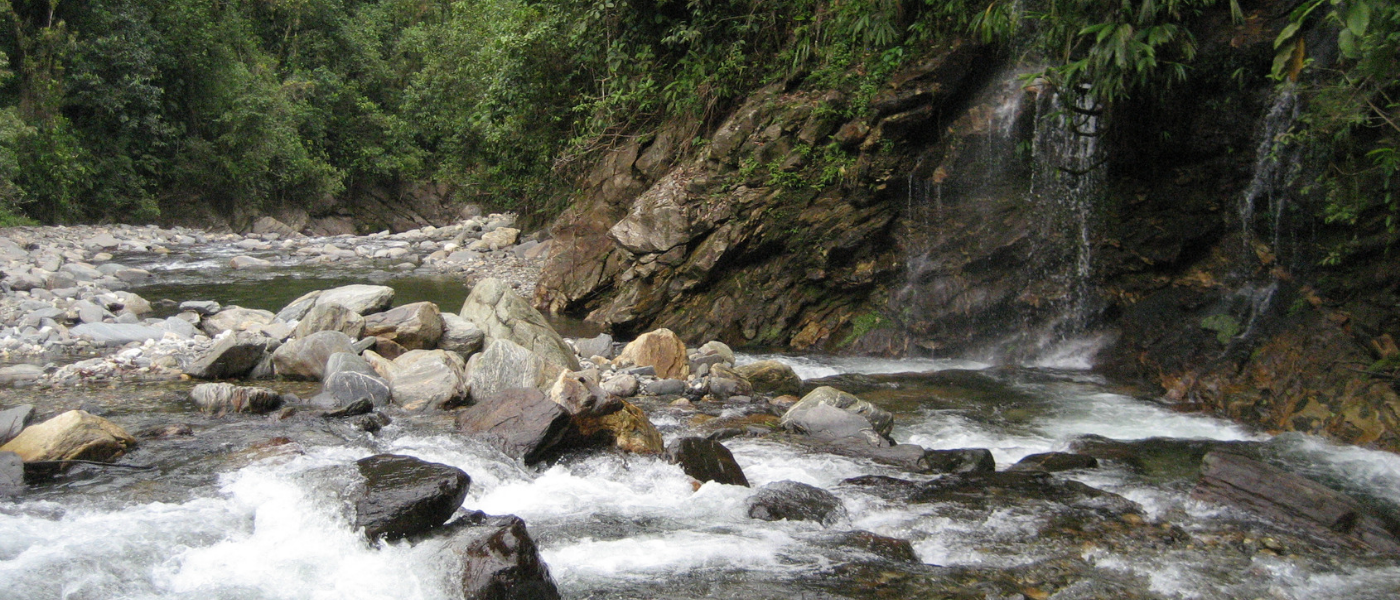
Rainfall, rivers, and thick jungle brush on the trail to Ciudad Perdida challenge even experienced hikers.
Nada: It was a privilege, and I truly mean that! Not everybody gets to go to Ciudad Perdida with the most knowledgeable archaeologist on the civilization, site, and region. It was an amazing experience.
Most of the visitors sleep in the lodge right before the Buritaca River, and the next day they go up for the day. If people have the physical ability to do that trip, it’s a must. Machu Picchu is a busy hike with a lot of tourists on the trails, but at Ciudad Perdida, you can hike for hours on your own, meeting campesinos and Indigenous communities. It’s a whole different level of travel and trekking.
Santiago: Tony Wheeler, who is on GHF’s board and the co-founder of Lonely Planet, says, “You might like Machu Picchu, but if you really like out of the way places, outstanding scenery, and beautiful architecture, you have to go to Ciudad Perdida.” That’s a pretty big thing to say!
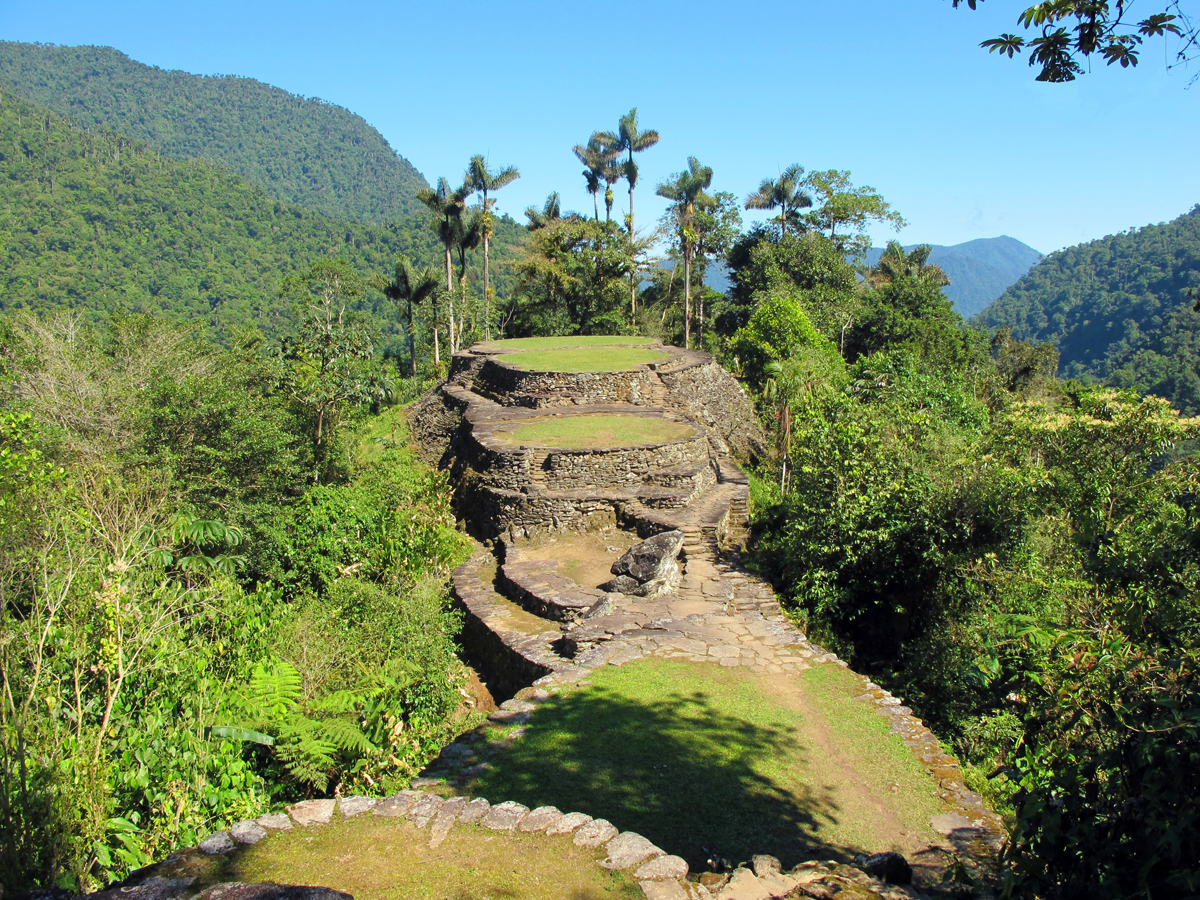
Central Terraces in Ciudad Perdida and surrounding views. Photo by GHF.
The unusual terraces at Ciudad Perdida are unlike other architectural features found in most of South America and the world.
What are the terraces at the Ciudad Perdida, and what makes them special?
Nada: A lot of visitors think the terraces are rice paddies. But they aren’t paddies; the people actually did them for a purpose.
Santiago: Yes, it was to set-up living areas in extremely broken topography. It’s an unconventional, open architecture and very different from what you see in most of South America and the world. It’s very difficult to understand.
It poses an archaeological and anthropological conundrum in terms of how they went about organizing space so that people could actually understand what was theirs and what wasn’t, what’s a private space and what’s a public space. There are no walls. It’s open architecture, and a completely different way of thinking about space compared to what we have now.
Nada: The VR [virtual reality] production we did a couple years ago was an opportunity to capture the difficulties going up the trails for people who physically cannot make it, and it was a way to make people understand the culture. There are a lot of stories around the culture that are not real; there’s a little fantasy about the Tayrona and that whole region. We thought that using Santiago’s research and PhD thesis, it would be useful and a good finishing touch before we completed the project.
How was it creating the film and engaging people who can’t make it to Ciudad Perdida themselves?
Santiago: There are a good number of people throughout the world who will not be able to visit Ciudad Perdida physically. Through either augmented reality or virtual reality, we wanted to setup an experience where you can be at a museum [and visit Ciudad Perdida].
It’s one thing to see a photograph of Ciudad Perdida, but it’s another thing to put on VR headphones or goggles. It is a very disorienting experience to be there but not be there. When we tried it out with people who had never been to Ciudad Perdida, they found it to be fascinating. For five minutes, they were able to see what is there and to hear the sounds of the forest, like the crowing of the birds, the insects, even the mosquitos flying. That’s part of the experience—a lot of people get bitten!
Nada: I can attest to that. When I was getting ready for the trip, Santiago warned me to bring ninety-nine percent DEET insect repellant. “Make sure you have poison on you!” But you still get bitten. When Joy and I were there, hundreds of mosquitos were flying around.
Santiago: Every time we filmed or did survey work, we were being bitten all the time. I would be doing an interview, and I’d be swatting away at mosquitos. It becomes second nature.
Besides hoards of mosquitos, what else may surprise visitors to Ciudad Perdida?
Nada: We flew out in a helicopter, and I was amazed at the amount of villages once you fly over the mountain range.
Santiago: Yes, the mountain is full of people. There are Indigenous villages, campesino villages in the lowlands, and all the archaeological remains. There’s a stereotype that the Sierra Nevada de Santa Marta is an empty landscape, but that’s untrue. It was inhabited during pre-colonial times, and it also has quite a population now. There are about 60,000 Indigenous inhabitants, and about 400,000 mestizo peasant farmers.
The inhabitants are spread out over a very large area, and all that area has archaeological remains. We’ve documented about 300 villages, and simply by extrapolation, we know that there should be about 600 villages total. It’s incredible.
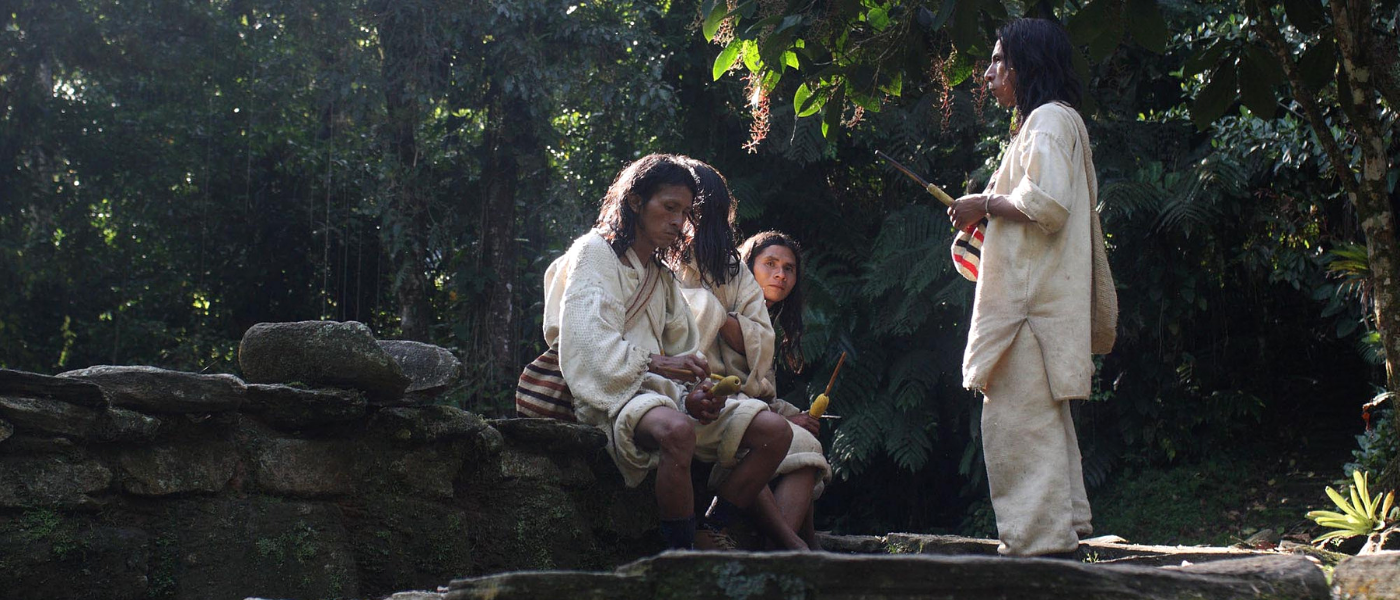
The communities at Ciudad Perdida consist of four groups: the Kogi, Arhuaco or Ijka, Wiwa, and Kankuamo.
Who are the communities and families that live at Ciudad Perdida?
Santiago: The upper part of the mountain is divided in four Indigenous reservations. Within these reservations, we have the majority of the Indigenous population, made of four groups: the Kogi, Arhuaco or Ijka, Wiwa, and Kankuamo.
Right now, all these Indigenous groups claim descent from the Tayrona. Of course, they did descend from Indigenous populations in the area. But they are the survivors of the survivors of the survivors of the survivors of the 16th century. During that 16th century, there was a huge population decline of up to ninety percent of the Indigenous population in the area due to diseases brought in by European settlers.
At this point, it’s literally impossible to trace a direct line of descent to any of the pre-colonial populations. However, these Indigenous populations have been living in the area for over 500 years now. In the surrounding area, there are non-reservation areas that are full of coffee farms and settlers who came in during the late part of the 19th century and early part of the 20th century.
In the case of the Buritaca River Basin where Ciudad Perdida is located, there hasn’t really been an Indigenous population there in terms of permanent settlements for over 400 years. The upper part of the basin began to be colonized by Indigenous settlers who came from other basins around the 1960s. There was also another influx of mestizo and campesino settlers from the lowlands during the 1960s.
Currently, only Indigenous peoples can live in the upper part of the basin where Ciudad Perdida is located. Around 1999, ICANH authorized the constitution of a traditional men’s house for Ronaldo, the mamo or religious specialist who is in charge of the spiritual protection of the site. He was literally raised by the archaeologists working there in the 1970s, and he has lived there off-and-on with his family for the past twenty years.
Santiago, you started research at Ciudad Perdida in 1999. Was that when violence erupted? How did you deal with that?
Santiago: Very irresponsibly! It was just pat of the job description. Every anthropologist and archaeologist working in Colombia had to deal with those conditions, whether we liked them or not. It was very sketchy and extremely dangerous.
When we went into the field at that time, we didn’t know if we were going to come out. It was pretty clear that something bad could happen to you—“bad” meaning be killed or mistaken for an army informant. We had to ask for permission from whatever forces were operating in the area, be they insurgency or paramilitary. If they said yes, we had present ourselves, explain what we were doing, and show that we were innocuous and not army informants. That was basically the situation we had to deal with from 1995 to 2007, when the paramilitary forces demobilized.
The situation kept going until last year when FARC [the Revolutionary Armed Forces of Colombia], which was our largest insurgent group, officially demobilized and reached a peace agreement with the Colombian government. So even up until last year, when people were working out in the field, there was always an element of danger. It was pretty complicated.
We are now in a post-conflict phase, and we have visitors from all parts of the country. There is an army platoon stationed at Ciudad Perdida for security purposes, because we do have accidents on the trail. They provide support if there is a bad accident. The risks right now are the risks of any backcountry trail: falling down the trail, hitting yourself, dislocated knees and shoulders, that sort of thing.
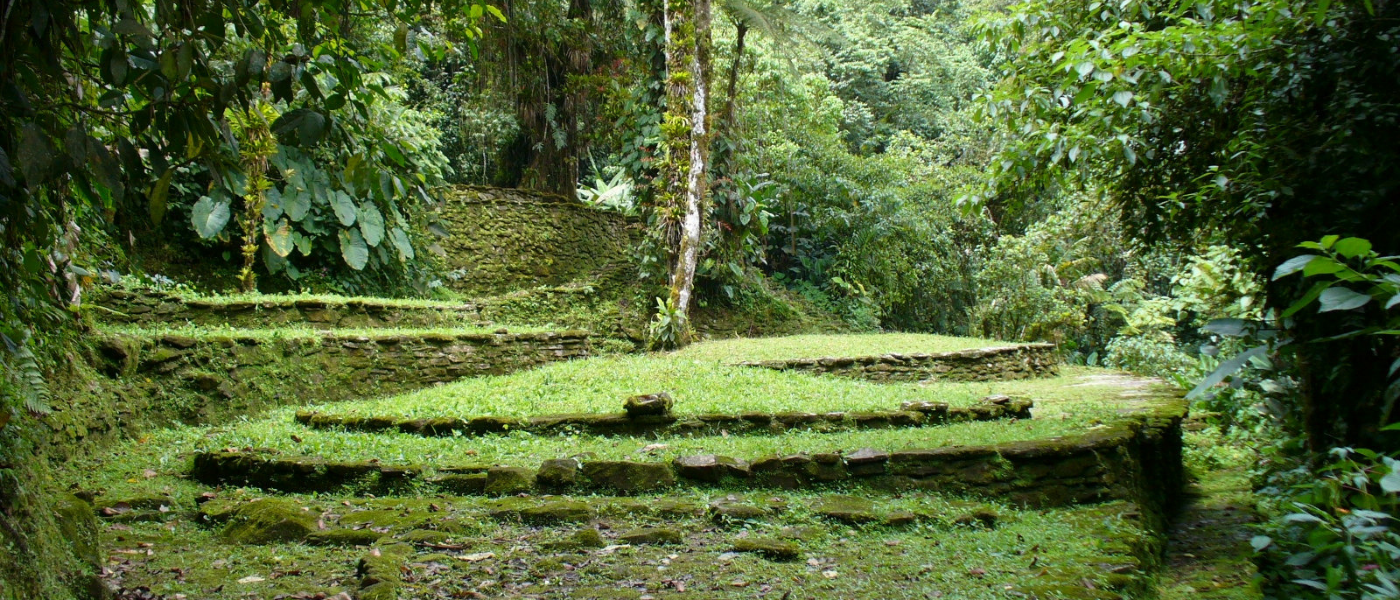
Archaeological sites are located along the trail to Ciudad Perdida.
Nada: Also the weather, because it’s raining all the time. It’s always wet and there’s a lot of erosion. Santiago even did a program a couple years ago planting trees.
Santiago: There are people in the area who used to farm or ranch for a living, so part of the project is to introduce landscape management practices. It’s fine to cut down trees to build houses, but we do need to replant trees. We setup a tree nursery and reforestation project along the trail and in different parts of the basin. Now we’ve handed it off to Environomica Foundation, and they’ve kept going with the nursery for the past three years now.
With GHF, we approached the whole project design process by thinking about different angles, from livelihoods to environmental conservation. We also did a biodiversity assessment and setup camera traps to see if tourism was impacting flora and fauna. We found that because tourists keep to the trail, their impacts are actually minimal.
It’s a very complex approach that we adopt to deal with all these issue. Ciudad Perdida is not just a cultural heritage site; there are also all the natural considerations. That’s actually what happens at most heritage sites—they are not simply cultural heritage. The division between natural and cultural heritage is one we have been questioning for many years now at GHF. A site can be a monument, but it’s still within an environmental and social context that must be addressed.
Are other GHF projects building on that interaction between local communities and their environments?
Nada: Absolutely. In Morocco, communities are dealing with desertification and migration. A lot of youth are moving north to look for jobs, but most people would prefer to stay with their families rather than migrate. It’s important that we create a sustainable system around an asset they already have, so they can build careers and families and stay where they are.
Santiago: When a site is truly important for a community, they will do everything they can to protect it, beyond whatever political, social, and economic changes a country might experience. One of GHF’s fortes is to provide tools so that no matter what happens, sites will be protected.
Nada: We give them are the initial tools, and then we let them take charge and make decisions. In a lot of instances, other international organizations will bring experts from the outside and tell people what to do. Then these experts leave with their knowledge, and nothing is given back to the locals.
Santiago: Sure. At Ciudad Perdida, it’s a very non-paternalistic approach to project building and project design. That’s extremely important!
As an example, we built a suspension bridge in 2012. Just two weeks ago, that bridge was replaced by a larger bridge, built and funded by the Indigenous community, so that mules can go over it. The bridge that we originally built will be relocated to an upper part of the river. That was done under the community’s own motivation and funding; we really had nothing to do with it. “If it works better for you to move the bridge, then go ahead and do it. You have to be proactive and do what needs to be done beyond what we like.”
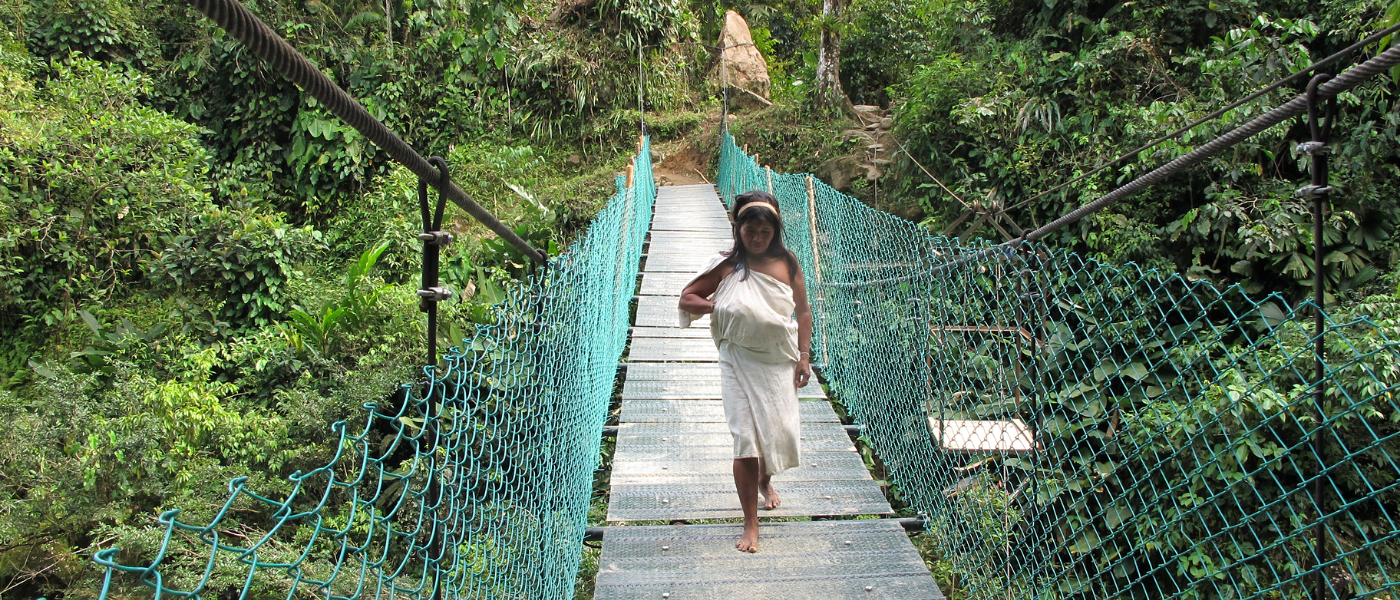
The bridge at Ciudad Perdida.
What’s next in Latin America for GHF?
Nada: Last year, Santiago and I went to Honduras. We looked at a site that was beautiful, but in a region on the border of Guatemala. The region is a little bit sketchy at this point, so we are waiting to see what happens.
Santiago: Yes, we visited Copán, one of the major Maya sites. It’s an absolutely gorgeous site, and it has what are deemed to be the finest examples of Maya 3D sculpture. We are currently waiting for the political situation to even out, to see if we can come in and provide some support for the site.
Nada: I also just got back from Mexico, and I was blown away by the heritage, culture, people, and the food.
Santiago: Mexico is fascinating, and it has loads of heritage sites. The INAH, The National Institute of Anthropology and History in Mexico, has been really good, but they are stretched very thin. It’s a huge undertaking to care for all the sites throughout Mexico, since it’s a very large country.
There’s also a bit of a security situation with the cartels, and it’s still complicated. But things need to be done. They have fantastic sites, and it would be a great opportunity for us to work there.
Nada: I have to say, I was in Oaxaca and didn’t feel uneasy at any point.
Santiago: That happened in Colombia with our own internal conflict. We felt things weren’t that bad, but there’s always an external perception of things being worse than they are.
What would you suggest for a trip to Ciudad Perdida? How much time should people plan, and how can visitors learn about options to see community development firsthand?
Santiago: There are a number of outfitters based out of the city of Santa Marta. For some of them, you can even book the trip online. Google “Ciudad Perdida tour” and a number of outfitters will pop up.
Normally it’s a four to five day trip. If you’re into ultra-marathons or trail-racing, it can be done in two days. But if you want to really enjoy the trip, understand the local communities, and see how Ciudad Perdida actually operates in context, it’s a four to five day trip.
The easiest thing is to fly into Cartagena or Bogotá and then take the trip to Santa Marta. You can decide which outfitter and local agency will suit you best. There’s also a guidebook that has all the information you need, including what to take. And we’ll have a new version of the book this year.
Nada: And do plan time to go to the beach afterwards!
Santiago: Yes, that’s a great recommendation. You’ll be completely disconnected at Ciudad Perdida, there’s no cell phone service or wifi. Then head to the beach to decompress. There are many small resorts and lodges on the beaches, from upscale to hostels. There are all sorts of places to stay on the coast.
…
Santiago Giraldo joined GHF as the Director of the Colombia Heritage Program, centering on developing a Master Management Plan for Teyuna-Ciudad Perdida Archaeological Park in the Sierra Nevada de Santa Marta Mountains of Colombia. He works closely with our partner institutions in Colombia such as the Instituto Colombiano de Antropología e Historia-ICANH, the Indigenous Authorities, local peasant councils, and other organizations on project development and implementation. His responsibilities also include directing site mapping and conservation assessment, as well as supporting GHF activities and projects in Peru and Guatemala.
Nada Hosking is GHF’s Director of Programs and Partnerships. In this capacity she is responsible for overseeing the management and coordination of all GHF projects and programs. Nada also manages funding allocation, project agreements, donor reporting, and project reporting for the GHF Board of Trustees. Additionally, she oversees strategy, activities, and institutional fundraising for several key GHF projects and programs.
Answers have been edited for clarity.

